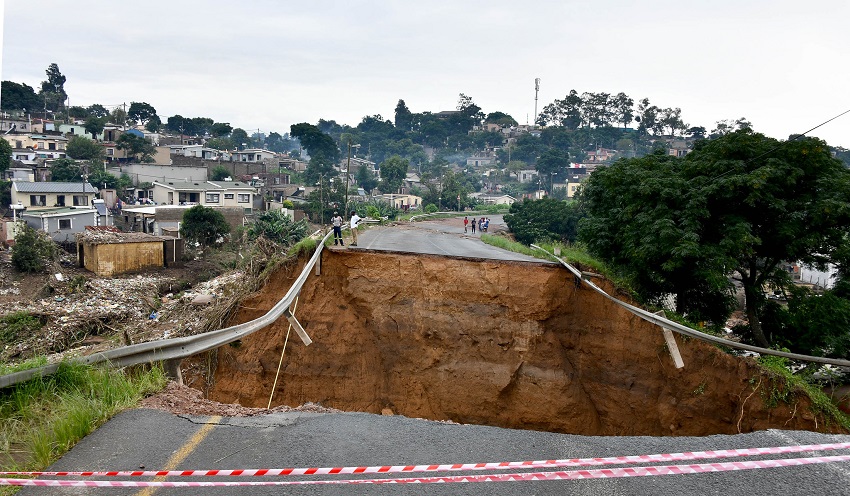KwaZulu-Natal, South Africa, April 2022

Cover Image: Local transport infrastructure was heavily damaged during the floods. President Cyril Ramaphosa visited flood-stricken parts of KwaZulu-Natal to offer support to affected communities and assess the response of government and civil society to this critical situation. Credit: GCIS, Government of South Africa. Licensed under Creative Commons, CC BY-ND 2.0 ( https://creativecommons.org/licenses/by-nd/2.0/ )
Days of heavy rainfall in south-eastern South Africa caused catastrophic flooding and landslides in the province of KwaZulu-Natal in April 2022. Thousands of homes were destroyed and over 400 people lost their lives. The government declared a National State of Disaster in response.
Flooding began after heavy rainfall from around 09 April 2022. The rain increased in intensity on 11 April with areas including Margate, Durban, Sezela, and Mount Edgecombe all receiving more than 300 mm of rain in 24 hours.
The KwaZulu-Natal provincial government said several rivers broke their banks, including the Amanzimtoti, Umbilo, and Umgeni.

Figure 1: Images acquired by the Copernicus Sentinel-2 satellites on 29 March and 28 April 2022. The Mlazi Canal flowing south of Durban was heavily affected, causing a landslide. Credit: European Union, Copernicus Sentinel-2 imagery. (More info here: https://www.copernicus.eu/en/media/image-day-gallery/disastrous-floods-south-africa)
In a statement of 18 April, South African President Cyril Ramaphosa said 443 people are known to have lost their lives in KwaZulu-Natal, around 48 people were still missing, and an estimated 40,000 people were displaced.

Figure 2: Emergency Response Coordination Centre (ERCC) – DG ECHO Daily Map, 19/04/2022, South Africa Floods and landslides. Credit: European Union, 2022. Map produced by the JRC. (More info: https://erccportal.jrc.ec.europa.eu/ECHO-Products/Maps#/maps/4042)
The rain, floods and landslides caused extensive damage to houses, businesses, roads, bridges and water, electricity, rail and telecommunications infrastructure, and disrupted fuel and food supplies.
“The lives, health and well-being of thousands of people are still at risk. The floods have caused great economic and social damage,” the President said.
eThekwini Metropolitan Municipality saw catastrophic damage. The municipalities of iLembe, Uthukela, King Cetshwayo, Ugu, uMgungundlovu, and Umzinyath were also severely impacted, according to the KwaZulu-Natal provincial government.

Figure 3: Extensive flooding caused displaced ~40,000 people. President Cyril Ramaphosa visited flood-stricken parts of KwaZulu-Natal to offer support to affected communities and assess the response of government and civil society to this critical situation. Credit: GCIS, Government of South Africa. Licensed under Creative Commons, CC BY-ND 2.0 ( https://creativecommons.org/licenses/by-nd/2.0/ )
In a report of 19 April, the International Federation of Red Cross and Red Crescent Societies (IFRC) reported 12,429 houses destroyed including 11,492 in eThekwini Metro alone.
Flooding also caused extensive damage to over 60 health facilities and hundreds of educational buildings affecting over 270,000 learners across the province.
Affected populations are exposed to high levels of food insecurity, water borne diseases and risks of COVID-19 infections. A majority are accommodated in evacuation shelters that are crowded with limited hygiene materials to use, according to the IFRC.

Figure 4: Extensive damage to private and public buildings, including health and educational facilities. President Cyril Ramaphosa visited flood-stricken parts of KwaZulu-Natal to offer support to affected communities and assess the response of government and civil society to this critical situation. Credit: GCIS, Government of South Africa. Licensed under Creative Commons, CC BY-ND 2.0 (link must be included: https://creativecommons.org/licenses/by-nd/2.0/ )
The President described the floods as a humanitarian disaster that calls for a “massive and urgent relief effort.”
By Karen O'Regan May 17, 2022, 2:23 p.m.
